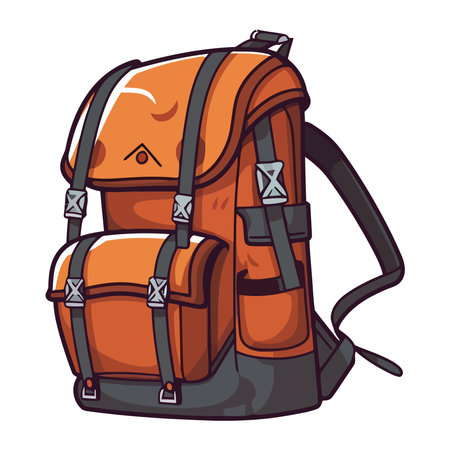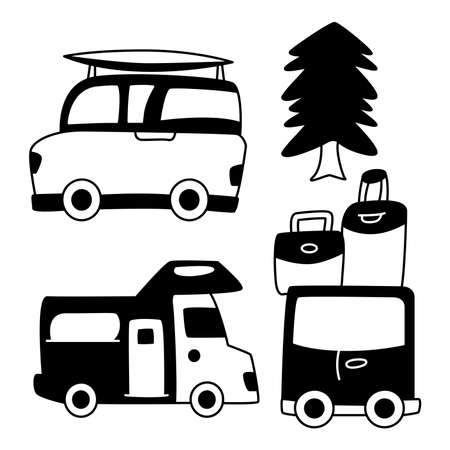1. Backpacking Pack and Weight Considerations
When it comes to backpacking across the U.S., whether youre tackling the rugged Rocky Mountains or wandering along the scenic Appalachian Trail, choosing the right backpack is one of the most important decisions you’ll make. Your pack not only carries all your gear—it also affects your comfort, endurance, and overall experience on the trail.
Choosing the Right Size
The first step is picking a pack that fits both your body and your trip’s needs. Backpacks are typically measured in liters. Here’s a simple breakdown:
| Pack Size (Liters) | Trip Length | Best For |
|---|---|---|
| 30-50L | 1-3 days | Short weekend trips, ultralight packing |
| 50-70L | 3-5 days | Most multi-day trips across U.S. trails |
| 70L+ | 5+ days | Extended treks or winter backpacking with bulky gear |
Ultralight vs. Traditional Packs
Backpackers in the U.S. often debate between going ultralight or sticking with traditional gear. Ultralight packs usually weigh under 2 pounds and focus on minimalism. They’re great for experienced hikers looking to move fast and light, especially in milder climates like parts of California or Arizona.
Traditional backpacks are heavier but offer more support, padding, and features like extra pockets and frames. These are ideal for beginners or trips through variable terrain such as the Rockies, where added support can make a big difference.
Quick Comparison:
| Type | Weight | Pros | Cons |
|---|---|---|---|
| Ultralight Pack | < 2 lbs | Lightweight, faster hiking, less fatigue | Less support, requires careful packing |
| Traditional Pack | 3-6 lbs | More comfort, better load distribution, durable | Heavier, may encourage overpacking |
Balancing Weight for U.S. Terrains
No matter which pack you choose, how you load it matters—especially when navigating steep climbs in the Rockies or long ridgelines in the Appalachians. Distribute weight evenly by placing heavier items close to your back and centered between your shoulders. Keep frequently used items like snacks or rain jackets near the top or in external pockets.
Packing Tip:
If you’re hiking through high elevation areas like Colorado’s mountains, keeping your pack light is key due to thinner air and steeper ascents. Meanwhile, on longer Appalachian hikes where resupply points are more frequent, consider packing fewer food items at a time to reduce weight.
Selecting the right backpack and learning how to manage its contents will set you up for a more enjoyable adventure across America’s diverse landscapes.
2. Shelter and Sleep Systems for Diverse Climates
When youre backpacking across the U.S., your shelter and sleep setup can make or break your trip. From muggy southern trails to chilly alpine regions, having the right gear for different environments is essential. Heres a look at the most common and reliable shelter options for backpackers exploring America’s wild landscapes.
Lightweight Tents
Backpacking tents are a go-to choice for many hikers because they offer full protection from the elements while remaining relatively light. When choosing a tent, consider weight, ventilation, and weather resistance. In humid areas like the Smoky Mountains, good airflow helps reduce condensation. In contrast, sturdy poles and strong rainflys are key for mountain regions where wind and sudden storms are common.
Top Features to Look For:
- Two-layer design: Inner mesh body + waterproof rainfly
- Freestanding setup: Easier to pitch on rocky terrain
- Vestibules: Extra room to store your pack and boots
Hammocks
Perfect for warm climates and wooded areas like the Appalachian Trail or Floridas Everglades, hammocks are a favorite among minimalist backpackers. Theyre lightweight, compact, and can be set up between two trees—no need for flat ground. Make sure to pair your hammock with a bug net and rain tarp if youre venturing into buggy or rainy zones.
Hammock System Essentials:
| Component | Description |
|---|---|
| Hammock Body | Main sleeping area made of durable nylon |
| Bug Net | Keeps mosquitoes and insects out in humid regions |
| Rain Tarp | Protects against rain and morning dew |
| Suspension Straps | Tree-friendly straps to hang your hammock securely |
Bivy Sacks (Bivouac Shelters)
Bivy sacks are great for solo backpackers looking to save weight while still staying protected. Theyre essentially waterproof covers for your sleeping bag—some even have small poles to create a bit of headspace. These work well in alpine zones or dry desert areas where setting up a full tent isnt necessary.
Bivy Sack Pros:
- Extremely lightweight (often under 2 lbs)
- Fast setup—ideal for stealth camping or quick overnights
- Packs down small, easy to fit in ultralight packs
Selecting Your Sleep System by Region
| Region | Recommended Shelter Type | Special Considerations |
|---|---|---|
| Southeast (e.g., Georgia, Carolinas) | Hammock with bug net & tarp | High humidity and lots of bugs—ventilation is key |
| Northeast & Midwest Forests | Tent or Hammock combo | Mosquito season can be intense; bring proper protection |
| Rocky Mountains & Sierra Nevada | Tent or Bivy Sack | Cold nights—even in summer; prioritize warmth & wind protection |
| Southwest Deserts (e.g., Arizona, Utah) | Bivy Sack or Freestanding Tent with mesh body | Drier air but exposure to wind and sun; bring shade options too |
The key to comfort on any backpacking trip is matching your shelter system to the environment you’re heading into. Whether you’re hanging between trees in Georgia or tucked into a bivy sack above the treeline in Colorado, being prepared means better sleep—and better adventure.

3. Hydration and Water Filtration On the Trail
Staying hydrated is a non-negotiable part of any backpacking trip, especially when youre tackling remote U.S. trails like the Pacific Crest Trail or hiking deep into the Grand Canyon. These environments can be harsh, dry, and unpredictable, making water sources scarce or questionable. That’s why having the right hydration system and water filtration gear is essential.
Popular Water Filtration Systems
When youre far from civilization, you cant always count on clean water. Here are some tried-and-true filtration systems that many U.S. backpackers rely on:
| Filtration System | Type | Best For | Pros | Cons |
|---|---|---|---|---|
| Sawyer Squeeze | Squeeze Filter | Lightweight Thru-Hikes | Lightweight, easy to use, long lifespan | Can clog if not cleaned regularly |
| Katadyn BeFree | Squeeze Filter | Fast Filtering On-the-Go | Quick flow rate, compact design | Filter life shorter than others |
| Pump Filters (e.g., MSR MiniWorks) | Pump Filter | Larger Groups or Dirty Water Sources | Effective against bacteria and protozoa, durable | Bigger and heavier, slower to use |
| Steripen Ultra | UV Purifier | Treated Clear Water Sources | Quick sterilization, no pumping needed | Requires batteries or charging, not for cloudy water |
Hydration Bladders vs. Water Bottles
The way you carry your water matters just as much as how you filter it. Many U.S. backpackers prefer hydration bladders for convenience, but there are pros and cons to each option:
| Hydration Method | Pros | Cons |
|---|---|---|
| Hydration Bladder (e.g., CamelBak) | Hands-free drinking, holds more water, fits in pack easily | Difficult to refill quickly on trail, harder to monitor intake level |
| Nalgene/Water Bottles | Easier to refill and clean, durable, visible water level | Takes up more space in pack pockets, less convenient while walking |
Chemical Treatment Options for Backup Safety
No matter what primary filter you carry, its smart to have a backup method—especially in emergencies. Chemical treatments like iodine tablets or chlorine dioxide drops are lightweight and effective against most pathogens.
Common Chemical Treatments:
- Aquamira Drops: Popular two-part chlorine dioxide solution; effective and lightweight.
- KATADYN Micropur Tablets: Easy-to-use tablets; kills viruses and bacteria but requires wait time.
- Iodine Tablets: Lightweight and cheap; leaves a noticeable taste.
If youre planning a trip through regions like the Sierra Nevada or desert stretches of Arizona, make sure your water plan includes both filtration and storage options tailored to those conditions. Always research your routes water availability ahead of time and prepare accordingly.
4. Clothing and Layering for American Weather Conditions
When youre backpacking across the U.S., youll experience a wide range of climates—from the humid heat of the Southeast to the dry deserts of the Southwest, and from chilly mountain peaks to damp coastal forests. Having the right clothing and layering system is essential to stay comfortable and safe no matter where your trail leads.
Why Layering Matters
Layering lets you adjust your clothing based on the weather, your activity level, and changes in temperature throughout the day. A proper layering system includes three key parts: base layers, mid-layers, and outerwear. Each has a specific job to do:
| Layer | Purpose | Recommended Materials |
|---|---|---|
| Base Layer | Wicks sweat away from your skin to keep you dry | Synthetic fabrics (like polyester), Merino wool |
| Mid-Layer | Adds insulation by trapping body heat | Fleece, down, synthetic insulation |
| Outer Layer (Shell) | Protects against wind, rain, and snow | Waterproof breathable fabrics like Gore-Tex or eVent |
Dressing for Different U.S. Climates
The climate can vary dramatically depending on where youre hiking. Heres how to prepare for common environments:
Desert Regions (e.g., Arizona, Utah)
- Daytime: Lightweight, breathable long-sleeve shirts and pants to protect from sun and heat.
- Nights: Pack a fleece or insulated jacket—desert temps drop fast after sunset.
- Shoes: Breathable hiking shoes with gaiters to keep sand out.
Tropical & Humid Areas (e.g., Florida, Southeast)
- Tops: Moisture-wicking short sleeves; avoid cotton as it stays wet.
- Pants: Quick-dry hiking pants or shorts with bug protection if needed.
- Socks: Wool-blend socks to manage sweat and prevent blisters.
Moutainous Terrain (e.g., Rockies, Sierra Nevada)
- Lows can be freezing even in summer—bring a puffy jacket or insulated layer.
- Avoid overheating during hikes by starting in light base layers.
- A waterproof shell is a must due to sudden storms.
Northern & Alpine Parks (e.g., Yellowstone, Glacier)
- Pile on layers—you’ll likely need all three at some point in the day.
- Mittens or gloves and a beanie are smart additions, even in early fall.
- Pants should be warm yet breathable—consider softshell materials.
Packing Tips
- Avoid cotton—it holds moisture and gets cold fast.
- Select gear that packs small but insulates well—like down jackets or compressible fleeces.
- If weight is a concern, choose multi-use items like convertible pants or jackets with zip-off sleeves.
Dressing smart for your backpacking adventure means being ready for anything Mother Nature throws your way. With the right layers in your pack, youll stay dry, warm, and ready to enjoy every mile of the trail.
5. Navigation Tools and Safety Essentials
When backpacking across the U.S., having the right navigation tools and safety gear is just as important as your tent or hiking boots. From the dense forests of the Pacific Northwest to the remote deserts of Utah, knowing where you are—and how to stay safe—is key to a successful trip.
Navigation Tools You Should Never Skip
Even with today’s technology, it’s smart to carry both digital and analog tools for navigation. Here’s a quick guide to what most experienced backpackers pack:
| Tool | Why Its Important |
|---|---|
| GPS Device | Offers real-time location tracking; especially useful in areas without cell service. Many models also include topo maps and emergency features. |
| Physical Map (Topographic) | Doesnt rely on batteries or signal. A must-have backup that helps you understand terrain and elevation changes. |
| Compass | Essential for orienting your map and determining direction if GPS fails. |
Safety Essentials for American Trails
The U.S. has some wild places—literally. Whether youre in grizzly country or hundreds of miles from the nearest town, these safety items can make all the difference:
| Item | Description |
|---|---|
| Bear Spray | A must-have in parts of the Rockies, Yellowstone, and other bear-prone areas. Works like pepper spray but designed for large animals. |
| Personal Locator Beacon (PLB) | Sends a distress signal with your exact GPS location to emergency responders. Ideal for backcountry trips where there’s no phone reception. |
| Whistle | A small but powerful tool for signaling help over long distances if youre lost or injured. |
Tried-and-True Tips
- Always let someone know your route and expected return time before heading out.
- If youre using a GPS device or smartphone app, bring extra batteries or a portable charger.
- Laminated maps are more durable and water-resistant than paper ones.
No matter where your backpacking adventure takes you in the U.S., packing the right navigation and safety gear gives you peace of mind—and could save your life in an emergency.
6. Cooking Systems and Trail Nutrition
When backpacking across the U.S., having the right cooking system and nutrition plan can make a big difference in your comfort and energy levels on the trail. American backpackers typically focus on lightweight gear that doesn’t take up too much space, is easy to use, and helps them prepare high-calorie meals quickly.
Lightweight Stoves
Backpackers in the U.S. often choose compact and efficient stoves that are easy to pack and fuel-efficient. Here are some popular types:
| Stove Type | Pros | Cons |
|---|---|---|
| Canister Stove | Lightweight, quick to boil, easy to use | Fuel canisters may be hard to find in remote areas |
| Alcohol Stove | Ultralight, cheap fuel options | Slower cook times, less wind-resistant |
| Wood-Burning Stove | No need to carry fuel, eco-friendly | Not allowed during fire bans, needs dry wood |
Cookware Essentials
The best cookware for backpacking is compact, durable, and multifunctional. Many hikers prefer titanium or aluminum pots because they are both lightweight and strong. A basic cook set usually includes:
- A small pot (for boiling water or cooking meals)
- A lid (which can double as a frying pan or plate)
- A spork or collapsible utensil
- A lightweight mug for hot drinks or soups
Trail Nutrition: High-Calorie and Convenient
When you’re burning thousands of calories a day hiking through mountain ranges or deserts, your food needs to be lightweight, high in calories, and easy to prepare. Here are some go-to choices for American backpackers:
| Food Type | Description | Why It’s Popular |
|---|---|---|
| Freeze-Dried Meals | Just add boiling water; ready in minutes | Tasty, long shelf-life, no cleanup required |
| Energy Bars & Protein Bars | Packed with protein, carbs, and fats in one bar | No prep needed, great for quick energy boosts |
| Nuts & Trail Mixes | A mix of nuts, dried fruits, chocolate or seeds | High in calories and healthy fats; customizable |
| Instant Oatmeal Packets | Add hot water for a warm breakfast option | Easy to prepare; good source of fiber and carbs |
Packing Tips for Food and Cooking Gear
- Portion Smart: Pre-measure servings to avoid carrying extra weight.
- Use Resealable Bags: Great for organizing snacks and reducing trash.
- Bare Minimum Cookware: One pot is often enough; keep it simple.
- Practice at Home: Try cooking with your stove before hitting the trail.
A reliable cooking setup combined with smart trail nutrition means you’ll stay fueled and focused during your backpacking adventure across America’s diverse landscapes.

